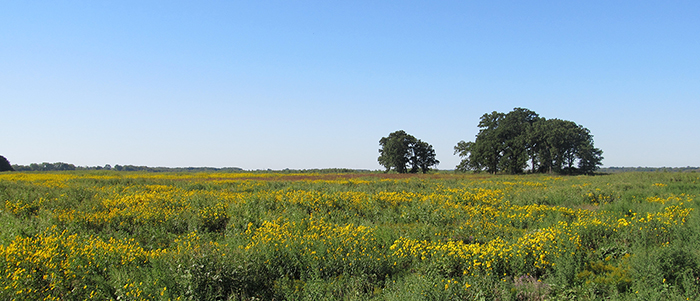Lake Mills Wildlife Area
Lake Mills Wildlife Area is comprised of a diverse variety of habitat types covering approximately 2,800 acres. The habitat types include open water marsh, large areas of wet prairie, lowland hardwoods with tamarack, and some oak savanna uplands. There is an excellent opportunity for hunting waterfowl, pheasant, deer, and small game.
This wildlife area is divided into two separate units. The eastern Lake Mills unit is primarily comprised of wetlands, including parts of three lakes (Rock Lake, Bean Lake and Mud Lake), extensive shrub-carr and southern tamarack swamp and some uplands with oak savanna and other hardwoods. This unit contains Bean Lake State Natural Area and the Mud Lake Fen and Wet Prairie State Natural Area. Also, there is an 80-acre class II dog training and trialing area.
The western Zeloski Marsh unit, which is part of the former, larger London Marsh, is comprised of restored wetlands with impoundments that provide opportunities to manage water levels for migrating and nesting waterfowl, shorebirds, and other wetland species. Large portions of the area have been planted with wet to mesic prairie species. The Zeloski Marsh unit contains several miles of dike-top access lanes maintained for management purposes, which provide excellent opportunities for walking, wildlife watching, and hunting. The Zeloski Unit was acquired by the Southern Wisconsin Bird Alliance (formerly Madison Audubon and donated to the Department in 2006. It was restored from agricultural drainage as part of the Federal Wetland Restoration Easement (WRE) program.
The Glacial Drumlin State Trail lies adjacent to the eastern unit along the north boundary and bisects the western unit of the wildlife area. This trail provides bicycle and foot access for a scenic spring, summer or fall outing. In the winter, it doubles as a snowmobile trail. Camping is also available near Lake Mills Wildlife Area at Sandhill Station Campground, part of the Glacial Drumlin State Trail.
Management Objectives
Historically, the eastern unit made up the entire Lake Mills Wildlife Area. This area is primarily comprised of wetlands including parts of three lakes, extensive shrub-carr and tamarack bog and uplands with oak savanna and other hardwoods.
The western unit is known as the London (Zeloski) Marsh. Zeloski marsh is comprised of large impoundments providing the opportunity to manage water levels for migrating and nesting waterfowl, shorebirds and other wetland species of both flora and fauna. Large portions of wet to mesic prairie communities have also been reestablished here.
The wildlife area is maintained and improved using several techniques including water level manipulation and drawdowns, prescribed fire, brush removal, planting of native species, and removal of invasive species. Farming agreements are also used to assist in preparing sites for permanent native prairie plantings.
The Glacial Heritage Area master plan was completed in 2011 and guides the long-term management of this property. Visit the property planning page for more information on master planning for this and other wildlife areas around the state.
Recreation
The Lake Mills Wildlife Area offers many recreational opportunities:
- Biking
- Birding
- Canoeing
- Cross-country skiing (no designated trail)
- Fishing
- Hiking (designated trail)
- Hunting (especially noted for waterfowl, pheasant, deer, turkey and small game)
- Snowmobiling (designated trails only)
- Kayaking
- Trapping
- Wild edibles/gathering (What can I collect?}
- Wildlife viewing
Amenities
- Bathroom? no.
- Parking lot? yes, there are 8 lots.
- Campground? not directly on this property; available at adjacent Sandhill Station Campground.
- Trails? yes, the Glacial Drumlin State Trail as well as maintained dike tops.
Special waterfowl regulations
In the Zeloski Marsh Unit of the Lake Mills Wildlife Area, hunting hours for all migratory birds will close daily at 1:00 p.m. beginning on Sept. 1 and continuing through the 16th day after the opening weekend of the duck season, except that normal statewide hunting hours apply on the opening weekend of the duck season.
Maps
Download a map of this property.
Download the map for the Zeloski Marsh Unit.
If you are interested in exploring this property further, you can access an interactive map.
Directions
Disclaimer: The DNR cannot guarantee the usage of every parking lot, as parking lots can close suddenly and for a variety of reasons. Weather, local water levels and county road closures may impact parking lot availability.
This wildlife area is divided into two separate units. The eastern unit is located immediately southwest of the city of Lake Mills. The western unit is about 2 miles further west. To find a parking area travel southwest of Lake Mills on Highway A. There is a parking area for the eastern unit immediately after Rock Creek on the left side. To visit the western unit, continue on Highway A to Highway S. Go north approximately 1 mile and turn west on Alley Road. The parking lot is located at the end of Alley Road on the north side.
Find out more about how to adopt wildlife areas.


